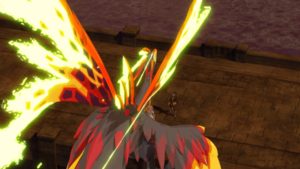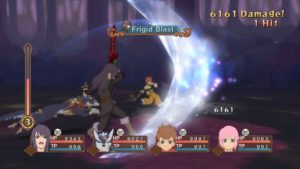Tales of Vesperia: Definitive Edition Review
TALES OF VESPERIA: DEFINITIVE EDITION REVIEW
Tales of Vesperia is an epic JRPG from Namco-Bandai. Originally released on the XBox 360, it was then expanded for the PS3 where it gained two extra playable characters along with new sidequests, items and abilities. More recently, a remastered version, the ‘definitive edition’, appeared on PC and consoles, giving players the chance to experience it again. That’s what we’re looking at today. It’s not the first time we’ve looked at it, we had a brief look at the original XBox 360 version demo many years ago.
A Long and Winding Road
Like many JRPGs, Tales of Vesperia is a sprawling tale that sees your band of heroes fighting for the existence of the world itself. But it is also a tale of friendship, with your team of loners and misfits gradually overcoming their personal demons as they try to figure out how to do the right thing in a confusing, morally ambiguous world.
There’s an environmental subtext to the story too, with humanity’s overuse of resources leaving the world imbalanced, causing an ever greater flood of monsters to besiege them.
Like most JRPGs, it is a long game. The story meanders, twists and turns, and you’d be forgiven for wondering exactly what is going on at certain points. The characters keep the game fun, however, and things do eventually gel.
The characters bond gradually through the game, and their interactions subtly change to reflect this. Some characters also have skills that complement each other, such as getting stat boosts when particular members are in the active team.
Aside from the story, there’s plenty to think about with side quests and various types of collectable to hunt down. There are costumes, titles, skills and combat moves to find, along with a monster book and item book to fill out.
The game doesn’t have a proper side quest tracker, and many of them are just a case of being in the right place at the right time. That means you’ll stumble across scenes hotch potch style as you revisit older areas. That makes keep of tracking things very tough, but does keep things interesting as you often get a surprise cutscene when heading back to a town, or resting at an inn.
There are all kinds of playable sub-games however, ranging from poker to snowboarding, to a kind of warehouse sokoban. A lot of the wider content is quite hard to stumble across on first playthrough. If you don’t consult a guide, you can easily miss a lot of what’s there. It doesn’t help that much of the additional content doesn’t become available until the endgame approaches.
That can make the game feel a lot more linear than it is. But once you start to figure out the various sidequests available to you, you’ll soon find yourself with far more to do than you have time for.
Finding everything is quite the task though, especially given the length of a single playthrough. It’s unlikely you’ll do everything without a guide, but you can carry quite a lot over from game to game. Tales games are designed for multiple playthroughs, and this is no exception. Most collectibles can be carried over. There’s plenty of replay value to be had working through the game again to get what you missed, and as you can carry powerful items through, your subsequent playthroughs get much quicker.
The Sights and Sounds of Terca Lumireis
Tales of Vesperia’s graphics are occasionally gorgeous, but do look a little flat sometimes. Character designs are great and there are a huge number of combat moves, many of which are spectacular, particularly the spells.
The remastered PC version allows you to play at 60 FPS, and has filters improving the game’s overall appeal. Unfortunately, it isn’t very well optimized, with microstutter appearing regularly to interrupt the game’s flow. It isn’t a deal breaker however.
Sound is pleasant enough. The music is mostly jaunty and pleasant but lacks the emotional punch of a good Final Fantasy, or the drama of Zelda. Character dialogue is excellent, and varied with the cast constantly bickering and bantering as they explore.
Stronger and Stronger
Combat is in real time with you taking control of one (or two, with a friend) of your team of four. You have a wide range of moves, which include basic attacks, artes and spells. Artes and spells use magic points, so these have to be managed.
You also learn new attacks as the game progresses. Some of these happen as you level up, some are taught during the story or in side quests. Others are learnt through skills, and these can be learned permanently if you do them repeatedly. In best RPG tradition once you get into the game you’ll be just as concerned with growing your abilities as you are about slaughtering the beasts in front of you.
You assign moves to controls yourself. Since the moveset evolves, and many of them are best in particular situations, you may find that you change them so fast, you never really know for sure which controls do what. Since you tend to gravitate towards using a few at a time you’ll probably end up with a set of favorites that you use a lot of the time, swapping others in and out as the situation demands.
You learn skills from weapons and characters will regularly learn these after battles, so much of your time is spent juggling weapons to ensure everyone is always learning something. When you face tougher monsters, you’ll want to prioritize your best gear over learning of course.
You have a limited amount of skill points to assign, and there’s plenty to choose from, ranging from various kinds of stat boosts to more subtle skills letting you chain different types of attack together. Learn to exploit these systems and you’ll be doing far more damage than would otherwise be possible, and will be much harder to knock down.
There are also special attacks, such as burst artes and mystic artes that become available later on. These use your limit gauge, which increases as you give and receive damage. Naturally, these are extra spectacular and best saved for tricky moments, or when you’re heavily outnumbered.
Your team members are very vocal during combat, and are a vital source of information. They’ll alert you to enemy weaknesses, status problems and poor health. There’s also a cooking system letting you make meals after each battle, giving various bonuses for the next fight if done successfully.
There’s a lot of depth in the combat system. With so many attacks and skills to think about, and them changing all the time, there’s plenty of room for experimentation. On standard difficulty, you’ll rarely die at the hands of standard enemies, though your magic points will tick down as your work your way between save points giving combat the attritional feel common to JRPGs.
Bosses are an exception, particularly the rare giga-monsters dotted around the world. These beasts give the game a bit of extra post-game interest, demanding the most from your team. Beyond these guys there are a few nasty surprises hidden away, but I’ll leave you to discover those yourself.
That’s Our Guild
The characterization in the game is great, and the cast all have their own interesting character arcs and side stories, with the banter between them evolving as you play.
Skits are unlocked as you move around the world and these provide a welcome interlude to combat. Many of them are attached to milestones or achievements, such as the first time you use a special attack in combat, or when a character cooks a particular dish.
The post combat dialogue also shines. It’s mostly throwaway lines and brief skits, but they evolve subtly, providing a further element of character growth alongside your stats and skills. For example, Rita, the game’s nerdy one, won’t want to participate in anything at first, but will eventually open up and join in enthusiastically with everyone else.
A Standout Tales Game
Tales of Vesperia is a long, epic adventure that still stands up well today. It meanders a little, but will suck you in, and its combat and late game challenges will keep you playing long after the credits roll.
Its broad cast of characters also shines, making the whole experience more enjoyable. Their trials and tribulations lend a human side that contrasts with the grandiose main storyline. You’ll watch your gang evolve into a finely honed fighting unit, capable of saving the world, and delivering a few snappy one liners while they do so.
Tales of Vesperia FAQ:
Publisher: Namco Bandai Games
Series: Tales
Release Date: August 7th 2008 (XBox 360), January 11th 2019 (Definitive Edition)
Platforms: XBox 360/One/Series X/S, PS3/4/5, PC, Switch, PS4,
Where to Buy: Steam, Amazon, Console Stores, Play Asia
Goods: Try this Tales site.
Standard Price: $49.99 on Steam
Estimated Sale Price: $9.99
Alternatives: Tales of Arise, Final Fantasy, Dragon Quest
Length: 70 Hours. How long to beat says 45 but that’s optimistic in our opinion.
You can follow any responses to this entry through the RSS 2.0 feed. You can leave a response, or trackback from your own site.





September 14th, 2023 at 9:49 am
Wow, 9000 hit points isn’t bad for the Koei wood
September 15th, 2023 at 5:12 pm
Yeah, I took my leveled characters back to some early dungeons to keep things less spoily, hence the hit points and impressive sword!